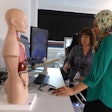
Despite the significant number of women radiologists in Italy, there exists a gender gap, which can be witnessed in horizontal and vertical segregation, according to a European Journal of Radiology (EJR) article published online on 15 May. The author recommends that policies should be introduced to counter the bias.
In Italy, women physicians have always been in the minority -- and are still currently fewer in number than men. However, these days, women make up more than 50% of all Italian medical school students and new medical graduates, according to a study by Dr. Nicola Magnavita, a specialist in occupational medicine from the department of public health at the Università Cattolica del Sacro Cuore in Rome.
 It appears that the gender gap is alive and well in Italy for women radiologists, Dr. Nicola Magnavita found.
It appears that the gender gap is alive and well in Italy for women radiologists, Dr. Nicola Magnavita found.With this increase of women in medicine, the question becomes, do they have the same chance as men of reaching the highest levels of a clinical or academic career (vertical segregation)? And are they underrepresented in some career specialties (horizontal segregation)? Lastly, do women doctors have higher levels of stress and mental fatigue than their male colleagues have?
Italian radiologists were asked to answer an anonymous questionnaire during two successive national radiology congresses. Out of a total of 654 respondents to the first questionnaire, 456 (69.7%) were men and 198 (30.3%) were women. In the second questionnaire, 610 were men (61.5%) and 382 were women (38.5%).
Magnavita found that women reported a psychophysical workload that was the same as that of their male colleagues, but claimed they had less control over their work, made a greater effort to fulfill job requirements, were more overcommitted in their work, and received fewer rewards for the work performed than men. Also, women had a significantly lower level of perceived justice than men.
In addition, there were not many female managers (vertical segregation), and there were not many women in radiology (horizontal segregation).
"On account of the lack of procedural, distributive, and informative justice, women radiologists perceived the work environment as significantly less fair compared to their male colleagues," Magnavita wrote. "Moreover, they derived less satisfaction from their job. They suffered from anxiety, depression, and minor psychiatric disorders to a greater extent than their male counterparts."
Women complained of a lower level of informative justice compared with men in their field -- they reported more frequently that their superiors tended not to be sufficiently sincere, reasonable, and transparent regarding work communications, he added.
"We therefore conclude that there is a gender gap in radiology in Italy," Magnavita wrote. "This result is not surprising in so far as it corresponds with what emerges from the literature on the status of women in medicine. However, to our knowledge, it is the first time that a gender gap has emerged in a country like ours where radiology is carried out mainly as a public service and is therefore not among the medical branches that provide higher earnings and that predominantly attract male physicians."
The observations in the study closely correspond to the major restraints that are believed to contribute to the glass-ceiling phenomenon in medicine: traditional gender roles, manifestations of sexism in the medical environment, and lack of effective mentors, he added.
"The overall picture that emerges from our research is one of false integration, in which women radiologists are formally treated in the same way as men (in fact, they do not perceive interpersonal injustice, nor lack of social support), have the same level of physical health and happiness, but make greater efforts to achieve career goals, get less recognition and less satisfaction from their work, and have a level of psychological well-being significantly lower than that of their male counterparts," he wrote.
Not a positive response
Although the study was conducted on Italian radiologists who participated in national congresses of the specialty, the response from the Italian scientific society of radiologists so far has not been positive, Magnavita stated in an email interview with AuntMinnieEurope.com.
Before submitting the paper to EJR, the manuscript had been sent to the most popular Italian journal of radiology, which is edited by the National Society of Radiology. One of the reviewers said "the subject had no scientific value and advised [me] to send the manuscript to a trade-union journal. So, the paper was rejected," Magnavita said. "I am convinced that this response confirms the existence of a gender gap in Italian radiology, and I hope that the work can help Italian radiologists to understand that the problem is not negligible."
There are, however, limitations to the study, Magnavita noted. The survey sample was self-selected and those who took part in the surveys might have been more hardworking, studious, and dedicated to their profession than those who did not.
"This prevents a universal comparison of our results, since the responses of those who did not participate may be different from those collected," he wrote in the study. "As use was made of a convenience sample, we cannot scientifically make generalizations about the total population of Italian radiologists from this sample because it would not be representative enough."
Randomization could increase the reliability of the research, but "we cannot find any reason why women radiologists would be induced to exaggerate their answers," Magnavita wrote. "The high number of respondents (1,646 questionnaires) makes us confident of the validity of our observations."
Also, the sample was taken from two surveys intended to study malpractice stress and workplace violence; because gender issues were not directly investigated, the researchers were able to avoid confirmation bias and other biases in judgment and decision-making that are so common in research on the gender gap.
"The gender gap must be fought not only for ethical reasons, but because it prevents human resources being used to the full," he noted. "Poor use of resources is a form of waste that our society can no longer afford in times of economic crisis."
Healthcare institutions should implement relatively simple measures supported by experimental evidence from other work environments such as the following:
- The introduction of the concept of stereotype threat to the medical community
- Involvement of all stakeholders, both men and women, in promoting identity safety by enacting and making people aware of policies to monitor potential instances of discrimination
- Training management to provide performance feedback that is free of gender bias
"Addressing both gender discrimination and violence simultaneously should be a priority in workplace violence research, workforce policies, strategies, laws, and human resources management training," Magnavita concluded. "This would go a long way to making workplaces safer and fairer for the health workforce and would be likely to improve workforce productivity and guarantee human rights at work."
















